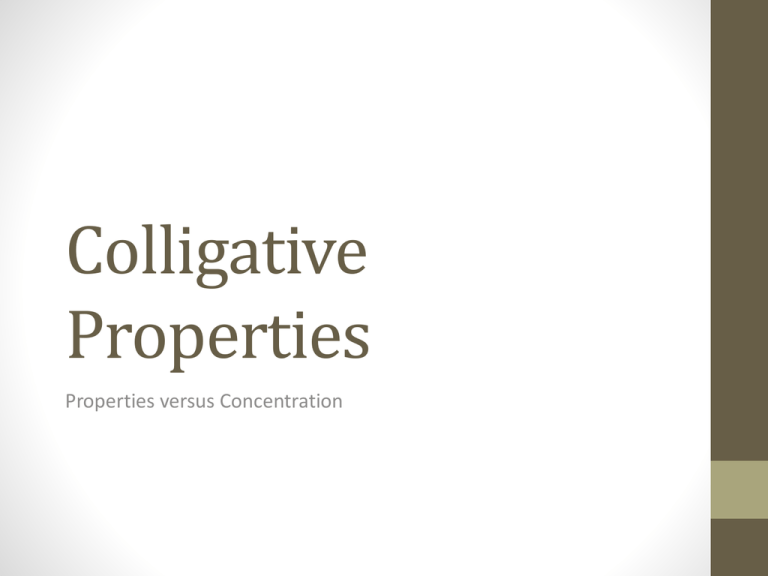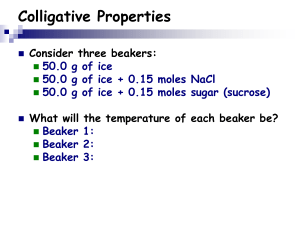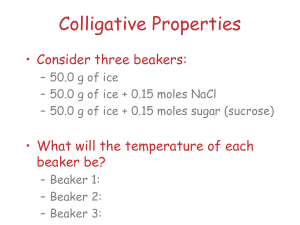Colligative Properties Properties versus Concentration
advertisement

Colligative Properties Properties versus Concentration Solution Properties • When you make a solution by adding the solute to the solvent, the resulting solution has a NEW, different set of physical / chemical properties. • The physical properties of the solvent, i.e. water in most cases, also changes when the solute is taken into solution. • Water may mix better / worse with other things than it did alone • Salt is added to icy sidewalks to melt the ice. • The salt, when taken into a H2O mixture, then gives the water a LOWER freezing point. This means the temp has to be lower outside for it to be icy. • Salts only work down to a specific temp. Changing FP’s / BP’s • When the salt lowers the water’s freezing point, the ice is able to melt at a lower temperature than it normally would. • This change is called freezing point depression. • You actually lower or DEPRESS the FP • Salts can also INCREASE the boiling points of some solvents • This change is called boiling point elevation. • i.e. glycol in a car increases the water’s boiling point so that it will not overheat your vehicle. It also lowers the freezing point at the same time so that it does not freeze up if you drive in cold temperatures. Colligative Properties • Any physical effect of the solute on the solvent is a colligative property. • Colligative Property – a property of a substance that is determined by the number of particles present in a system but independent of the properties of the particles themselves. • i.e. water vs water-salt soln. • The lowering of freezing points and the elevating of boiling points are colligative properties. Colligative Props and Conc. • The extent of the effect of the colligative property depends on the concentration of solute in the solution. • The greater the amount of solute in solution, the greater the freezing point may be depressed. • The more PARTICLES in the solute (ions or molecules) the greater the effect. • Sugar water (C6H12O6) will dissolve as 1 particle • Sodium Chloride (NaCl) will dissociate into ________________ and will have ________ times the effect. • Magnesium Chloride (MgCl2) will dissociate into ________________ and will have ________ times the effect. Vapor Pressure • Colligative properties are all cause by a decrease in the vapor pressure of the solvent. • The higher the number of solute particles, the lower the number of solvent particles per unit volume. • Since there is a lower amount of liquid solvent to dissolve, there is a decrease in the vapor pressure of the system. • Vapor pressure will therefore be decreased in proportion to the number of solute particles. Solute Effects on the Vapor Pressure of a Pure Solvent Surfactants • A surfactant is a compound that concentrates at the boundary surface between two immiscible phases, solid-liquid, liquidliquid, or liquid-gas. • Soap is a surfactant. It is a long chain of nonpolar hydrocarbons that are able to clean oils and grease that water would leave behind. Why do you think this is? • A detergent is a surfactant that is used for cleaning purposes ONLY. It is water soluble and can emulsify dirt and oil. • Soap is a substance that is used as a cleaner and dissolve in water. Hard Water • Hard water limits soap’s detergent ability. • The ions in the “hard water” will bond to and react with the ions in the soap, lowering the effectiveness of the soap. • Review: • What carries an electric current through a solution? • Why does tap water conduct electricity, whereas distilled water does not? • What affect does a solute have on the boiling point of the solvent? • Why does spreading salt on an icy sidewalk cause the ice to melt? • Will 1 mol of sugar have the same effect as 1 mol of table salt in lowering the freezing point of water?





